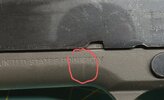Tallinar
Member
Hello,
A few years ago, I inherited my grandfather's 1911, which he shot in various steel challenge-type matches over the years. I believe he acquired it sometime in the 50's or 60's, and he shot it a lot. By my limited estimation, it is an original non-A1 Colt 1911 frame built circa 1918, in which the frame (SN: No. 407247) is possibly now the only original part. I get the impression that my grandpa replaced parts over time both as they encountered wear and as he attempted to sporterize it to meet his fancy.
The frame has US ARMY and UNITED STATES PROPERTY markings. It also has an RIA stamp, which based on my limited research indicates it was re-serviced at RIA at some point in time. There are signs of light cracking on both the left and right side of the frame.
The slide is blued, marked Remington Rand. The barrel is serialized, but I don't recognize at a glance who the manufacturer would be. The bushing is also serialized, but does not match the barrel. Based on serial numbering scheme, I am guessing the barrel and bushing are distant cousins of the same manufacturer. Straight mainspring housing. Spur hammer.
Looks to have an aftermarket elongated trigger. Target sights. Pachmayr wrap-around grips (which he apparently shimmed on the left side with some random material that happened to be around, which is totally consistent with something my grandpa would have done .
.
All in all, I expect it has virtually no value as a shooter, and little value as a collector piece given that nothing is original. Nonetheless, I'd like to establish a value. I'm wondering if there's any interesting history here that eludes me. Would appreciate any insight. Thanks!
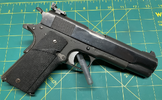
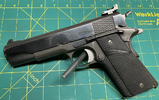
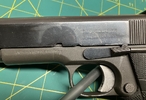
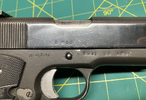
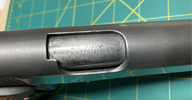
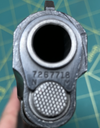
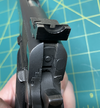
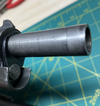
A few years ago, I inherited my grandfather's 1911, which he shot in various steel challenge-type matches over the years. I believe he acquired it sometime in the 50's or 60's, and he shot it a lot. By my limited estimation, it is an original non-A1 Colt 1911 frame built circa 1918, in which the frame (SN: No. 407247) is possibly now the only original part. I get the impression that my grandpa replaced parts over time both as they encountered wear and as he attempted to sporterize it to meet his fancy.
The frame has US ARMY and UNITED STATES PROPERTY markings. It also has an RIA stamp, which based on my limited research indicates it was re-serviced at RIA at some point in time. There are signs of light cracking on both the left and right side of the frame.
The slide is blued, marked Remington Rand. The barrel is serialized, but I don't recognize at a glance who the manufacturer would be. The bushing is also serialized, but does not match the barrel. Based on serial numbering scheme, I am guessing the barrel and bushing are distant cousins of the same manufacturer. Straight mainspring housing. Spur hammer.
Looks to have an aftermarket elongated trigger. Target sights. Pachmayr wrap-around grips (which he apparently shimmed on the left side with some random material that happened to be around, which is totally consistent with something my grandpa would have done
All in all, I expect it has virtually no value as a shooter, and little value as a collector piece given that nothing is original. Nonetheless, I'd like to establish a value. I'm wondering if there's any interesting history here that eludes me. Would appreciate any insight. Thanks!










